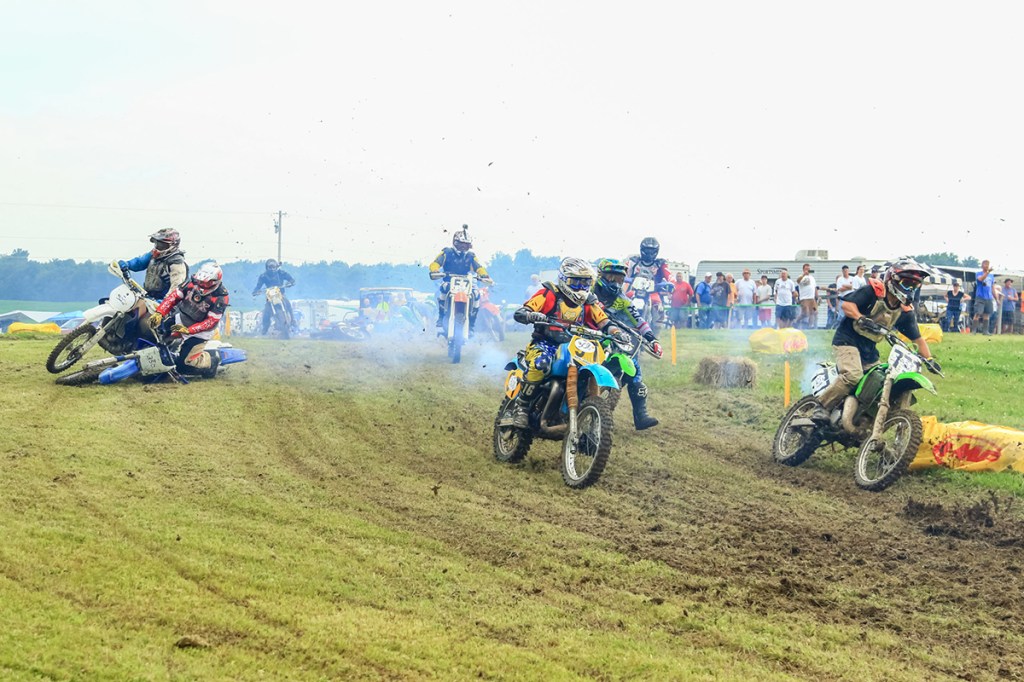Each July, the American Motorcyclist Association — the policy advocacy organization for motorcycle riders — holds Vintage Motorcycle Days, a weekend-long celebration of old bikes. My father and I attend in whichever years the work and family commitments of summer allow for a momentary escape. Vintage Days is indeed an escape from all of these things, and in many ways, from the normalcy of polite society.
This is because the AMA, an organization which normally stresses safe and courteous riding, allows Vintage Days attendees to cut loose. The event is held at Mid-Ohio Sports Car Course, a race track with a large campus that allows for a swap meet, seminars, campgrounds, bike shows and all disciplines of dirt and road racing. Those are only the organized activities, however. Upon entering the main gate, you immediately notice a billboard that sets the tone: “What Happens at Vintage Days Stays at Vintage Days,” the sign says, below the AMA’s logo.
What happens at Vintage Days is an expression of the full range of human nature. There is a family-friendly camping area, and many families attend with their young children. I saw more than one family roasting marshmallows or releasing Chinese lanterns into the Ohio night sky.
The main campground, on the other hand, is given over to debauchery and motor-powered mayhem. The air is thick with smoke, dust, and the sickly-sweet scent of fumes from old two-stroke dirt bikes, which run on a mixture of gasoline and oil. The garbage bins are laden with empty beer cans. In the center of the campground, those with steely nerves convene at all hours of the day and night for barrel racing, a decidedly unsanctioned activity which involves moving in aimless, endless circles on dirt bikes, quads, motorcycles and golf carts. Many of these vehicles don’t come equipped with headlights, but this doesn’t slow the pace after dark. Riders just duct-tape flashlights to their bikes, or else wear LED headlamps of the kind favored by hikers.
In one corner of the campground is a yearly burnout competition. In another, a metal band plays a set, illuminated by a pyrotechnic device that occasionally shoots flames twenty feet into the air. One of the funniest things I have ever seen at Vintage Days occurred a few years ago during the burnout competition. As a contestant spewed smoke and burnt rubber into the air, someone set off a firecracker too close to the burnout box. The emcee railed on the microphone, indignant. “Whoa, whoa, whoa, you guys. The sheriff’s department has informed us that no fireworks are allowed anywhere near this burnout competition. That’s not safe, guys!” Heh.
While spectating the burnouts this year, I caught up with the “bourbon fairy,” a large man wearing a tutu, lighted wings from a girl’s Halloween costume and a garden sprayer on his back. He thrust the nozzle towards my mouth. We hadn’t met by name, so I cautiously asked, “What’s in that thing? Bourbon? Proceed.” It turned out that he was with Cleveland Moto, a combined motorcycle sales and repair shop and podcasting collective, the associates of which approach legendary status for their Vintage Days antics. The shop owner, Phil Waters, usually brings a retrofitted bus or some other outrageous vehicle to function as his base of operations. By day, he hosts live podcasts in the AMA events tent and sells motorcycles at the swap meet.
My encounter with the bourbon fairy notwithstanding, I’m not much of a partier myself. I attend mostly for the people-watching — you’d be excused for comparing the vibe to Barter Town, the setting of the dystopian classic Mad Max Beyond Thunderdome — and for my love of motorcycles. I only started riding in my mid-thirties a few years back, but my father, now in his late sixties, has been riding for sixty years. He was the head mechanic for my grandfather, a small-scale Triumph motorcycle dealer in the Sixties and Seventies and spent decades of Saturdays as an amateur dirt bike racer. As we walk up and down the aisles of the swap meets and bike shows, he teaches me about what it was like to ride, own, or work on the classics. “I never owned one of those,” he said about a lovingly restored BSA 441 Victor, “but your grandfather and I had a customer who would race one each weekend and come in on Monday and have us go over it for the next week. We’d retighten the fasteners and adjust the chain tension. Now these things are too rare to actually ride. Look at how spotless this one is!”
Like all relatively scarce assets, prices on old motorcycles have spiked recently due in part to the increasing nostalgia of baby boomers and the momentary infusion of capital into the economy with the Covid stimulus packages. Walking up and down the aisles of the swap meet — supposedly the largest one in North America — we could see that the prices reflected this upwards shift in value. Some vintage dirt bike that might have commanded a thousand dollars pre-Covid would be on sale for five this year. I myself own a 1978 Honda CB750, a particularly beloved classic road bike. I paid about $2,000 in 2017 — the ’78 is not a particularly sought-after year for the model. But I saw similar bikes up for grabs for well over double that and in far worse condition.
It didn’t seem to us like there were many takers, though. We’d circle back each day and note the same bikes, now with lower prices. A vendor put a sign outside his trailer that captured the anxieties of the moment. “Due to the current economy and inflation, our prices have increased to reflect the value of the US dollar. Vote better!” On the wall of a portable toilet nearby, someone scrawled “FJB. Our new dictator, Joseph Stolen.” You can detach from society for a weekend, but you can’t escape political and economic tensions any more than you can escape human nature.
There are always upsides even in the darkness, though. A surprise rainstorm flooded our tent with six inches of water. (The track has a well-earned nickname of “Mud Ohio” for its frequent bouts of unpredictable weather.) The man in the tent next door, a fleet mechanic for the postal service named Tim, felt bad for us as we bailed out the water and desperately tried to dry our belongings before nightfall. He gave us some pork loin and baked potatoes.
At breakfast on Sunday morning, some old salt struck up a conversation. He said he was a five-time national champion in a desert racing discipline called “hound and hare.” Having traveled all over, he offered that, “90 percent of people you encounter are great, but man. That last ten percent.” Amen to that.


















